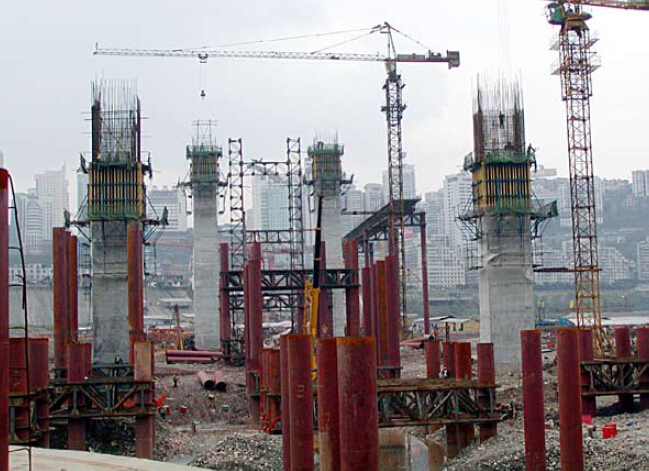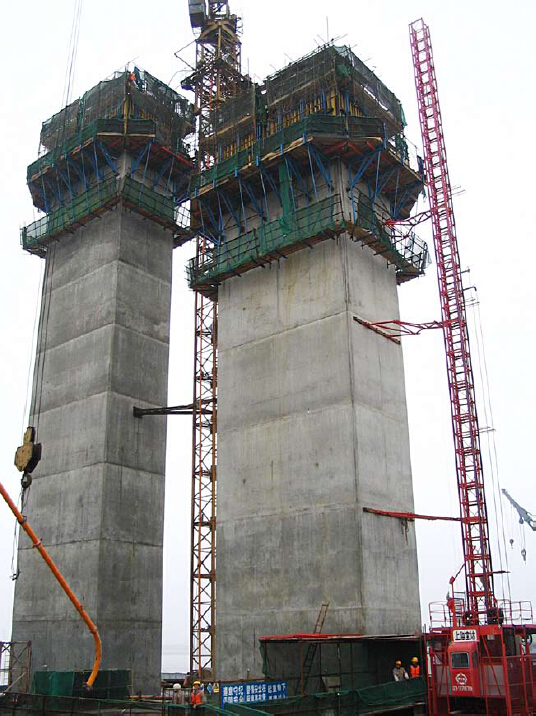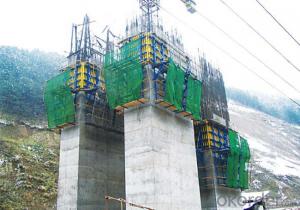Climbing-bracket CB-240 for formwork and scaffolding system
- Loading Port:
- Tianjin
- Payment Terms:
- TT OR LC
- Min Order Qty:
- 50 m²
- Supply Capability:
- 1000 m²/month
OKorder Service Pledge
OKorder Financial Service
You Might Also Like
Climbing Bracket CB240 & CB210
They are framework brackets for supporting large-area wall formwork.
Typical applications for the CB240&CB210 are pier and column/shear wall/core walll/ in the
building.
CB210 has smaller size than CB240, it will be cost effective in some condition.
Characteristics:
◆ High bearing capacity
The high loading capacity of the brackets allow very large scaffold units. This saves the number
anchor points required as well as reducing climbing times.
◆ Simple moving procedure by crane
Through the strong connection of formwork together with the climbing scaffold, both can be moved
as a single climbing unit by crane. Thus valuable time-savings can be achieved.
◆ Fast striking process without a crane
With the retrusive set, large formwork elements can also be retracted quickly and a minimum of
effort.
◆ Safe with work platform
The platforms have assembled firmly with bracket and will be climbing together, without scaffolding
but can work safely in spite of your high location.


- Q:Can steel formwork be used for both above-ground and below-ground structures?
- Yes, steel formwork can be used for both above-ground and below-ground structures.
- Q:What are the different surface treatments available for steel formwork panels?
- Steel formwork panels can be treated with various surface treatments to enhance their durability and performance. Some common options include: 1. Galvanization: By immersing the panels in molten zinc, a protective layer is formed on the surface. This treatment is ideal for outdoor and highly corrosive environments due to its excellent corrosion resistance. 2. Powder coating: A dry powder coating is applied to the steel surface and then cured under heat. This provides a durable and visually appealing finish with resistance to corrosion, abrasion, and chemicals. Additionally, a wide range of colors and textures can be achieved. 3. Epoxy coating: Liquid epoxy coatings are applied to the steel surface and then cured to create a hard and protective layer. This treatment offers exceptional resistance to corrosion, chemicals, and abrasion, making it suitable for harsh conditions. 4. Paint: Various types of paint can be used to create a protective layer and improve aesthetics. The level of resistance to corrosion, UV radiation, and wear depends on the specific paint used. 5. Shot blasting: High-speed steel shot or grit particles are used to blast the surface of the steel formwork panels. This process removes rust, scale, and contaminants, creating a clean and roughened profile that enhances the adhesion of subsequent coatings. 6. Hot-dip aluminizing: The panels are immersed in molten aluminum to form a thin layer on the surface. This treatment offers excellent corrosion resistance and heat reflectivity. These surface treatments provide different levels of protection against corrosion, abrasion, chemicals, and environmental factors. The choice of treatment depends on the specific application and desired durability.
- Q:How does steel formwork affect the overall waste management of the construction process?
- Steel formwork can have a positive impact on the overall waste management of the construction process. Unlike traditional timber formwork, steel formwork can be reused multiple times, reducing the amount of waste generated during construction. This not only minimizes the need for raw materials but also decreases the amount of waste that needs to be disposed of. Additionally, steel formwork is more durable and resistant to damage, further extending its lifespan and reducing waste. Overall, the use of steel formwork in construction can contribute to a more sustainable and efficient waste management system.
- Q:How does steel formwork affect the overall construction waste management?
- Steel formwork can significantly impact overall construction waste management by reducing waste generation and improving recycling opportunities. Unlike traditional timber formwork, steel formwork is more durable and can be reused multiple times, reducing the amount of waste generated during the construction process. Additionally, steel formwork can be easily dismantled and transported, allowing for efficient recycling and proper disposal of construction waste. This not only minimizes the environmental impact but also reduces the cost associated with waste disposal, making steel formwork a more sustainable and cost-effective solution for construction waste management.
- Q:Can steel formwork be used for sports complex construction projects?
- Sports complex construction projects can indeed utilize steel formwork. When it comes to shaping and building the necessary structures for such complexes, steel formwork proves to be a versatile and durable option. Its application extends to constructing walls, columns, beams, and slabs within the complex. Steel formwork possesses the strength and stability required for larger spans and higher load-bearing capacities, qualities often necessary for sports facilities. Moreover, the use of steel formwork yields a smooth finish, contributing to a professional and visually appealing appearance. In conclusion, steel formwork stands as a suitable choice for sports complex construction projects due to its strength, flexibility, and ability to efficiently create complex structures.
- Q:What is the weight of steel formwork panels?
- The weight of steel formwork panels can vary depending on their size and thickness. On average, a standard steel formwork panel might weigh between 50 to 70 kilograms (110 to 155 pounds).
- Q:How does steel formwork contribute to the overall speed of construction?
- There are several ways in which steel formwork speeds up construction. Firstly, its high strength and durability allow it to handle the pressure and weight of wet concrete. This means that construction teams can pour concrete into the formwork and continue with the next steps without waiting for it to fully cure. As a result, the overall construction time is significantly reduced. Furthermore, steel formwork is highly reusable, unlike traditional timber formwork which needs frequent replacement. This means that construction crews can move from one section to another without constantly preparing new formwork. This saves both time and resources, further enhancing the speed of construction. In addition, steel formwork offers better precision and accuracy compared to other types. Its rigid structure ensures that concrete is poured and shaped exactly as intended, reducing the need for costly adjustments. This precision allows construction teams to proceed with subsequent tasks without delay. Moreover, steel formwork is lightweight and easy to handle, making it quick to assemble and dismantle. This ease of use allows construction crews to set up the formwork system swiftly, reducing installation time. Similarly, when the concrete has cured, the steel formwork can be easily disassembled and moved to the next site, further speeding up the construction process. In conclusion, the strength, durability, and reusability of steel formwork contribute to the overall speed of construction. Its precision and ease of handling also play a significant role in accelerating the process. With these advantages, construction teams can complete projects more efficiently, saving time and reducing costs.
- Q:Can steel formwork be used in high-rise construction?
- Yes, steel formwork can be used in high-rise construction. Steel formwork offers high strength and durability, making it suitable for withstanding the high pressures and loads experienced in tall buildings. It also provides excellent dimensional accuracy, allowing for precise construction and ensuring the structural integrity of the high-rise building. Furthermore, steel formwork can be easily assembled and disassembled, making it a time-efficient choice for large-scale projects.
- Q:How does steel formwork contribute to the strength and stability of a concrete structure?
- Steel formwork contributes to the strength and stability of a concrete structure by providing a rigid and durable framework that holds the freshly poured concrete in place until it sets and hardens. The steel formwork acts as a mold, ensuring that the concrete is poured into the desired shape and dimensions, and also prevents any deformation or collapse during the curing process. Its strength and stability ensure that the concrete structure maintains its integrity and can withstand various loads and forces, thereby enhancing its overall strength and durability.
- Q:Can steel formwork be used for both simple and complex architectural designs?
- Yes, steel formwork can be used for both simple and complex architectural designs. Steel formwork is highly versatile and can be shaped and customized to various shapes and sizes, making it suitable for both simple and complex architectural designs. It offers a high level of flexibility and can be easily adjusted to create intricate and unique forms. Additionally, steel formwork provides excellent strength and stability, allowing it to withstand the pressures and forces exerted during the concrete pouring process. This makes it ideal for constructing structures with complex shapes and designs. Furthermore, steel formwork is durable and reusable, which makes it cost-effective for projects involving both simple and complex architectural designs. Overall, steel formwork is a reliable and efficient solution that can be used in a wide range of architectural designs, regardless of their complexity.
1. Manufacturer Overview |
|
|---|---|
| Location | |
| Year Established | |
| Annual Output Value | |
| Main Markets | |
| Company Certifications | |
2. Manufacturer Certificates |
|
|---|---|
| a) Certification Name | |
| Range | |
| Reference | |
| Validity Period | |
3. Manufacturer Capability |
|
|---|---|
| a)Trade Capacity | |
| Nearest Port | |
| Export Percentage | |
| No.of Employees in Trade Department | |
| Language Spoken: | |
| b)Factory Information | |
| Factory Size: | |
| No. of Production Lines | |
| Contract Manufacturing | |
| Product Price Range | |
Send your message to us
Climbing-bracket CB-240 for formwork and scaffolding system
- Loading Port:
- Tianjin
- Payment Terms:
- TT OR LC
- Min Order Qty:
- 50 m²
- Supply Capability:
- 1000 m²/month
OKorder Service Pledge
OKorder Financial Service
Similar products
New products
Hot products























